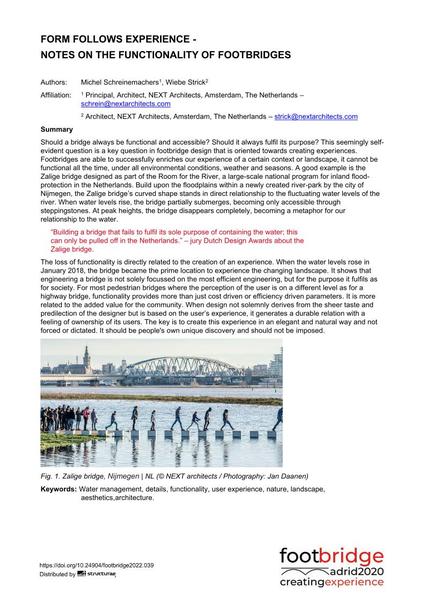Form Follows Experience - Notes on the Functionality of Footbridges

| Author(s): |
Michel Schreinemachers
(Principal, Architect, NEXT Architects, Amsterdam, The Netherlands)
Wiebe Strick (Architect, NEXT Architects, Amsterdam, The Netherlands) |
|---|---|
| Medium: | conference paper |
| Language(s): | English |
| Conference: | Footbridge 2022: Creating Experience, Madrid, Spain, 07-09 September 2022 |
| Published in: | Footbridge Madrid 2022 - Creating Experience |
| DOI: | 10.24904/footbridge2022.039 |
| Abstract: |
Should a bridge always be functional and accessible? Should it always fulfil its purpose? This seemingly self- evident question is a key question in footbridge design that is oriented towards creating experiences. Footbridges are able to successfully enriches our experience of a certain context or landscape, it cannot be functional all the time, under all environmental conditions, weather and seasons. A good example is the Zalige bridge designed as part of the Room for the River, a large-scale national program for inland flood- protection in the Netherlands. Build upon the floodplains within a newly created river-park by the city of Nijmegen, the Zalige bridge’s curved shape stands in direct relationship to the fluctuating water levels of the river. When water levels rise, the bridge partially submerges, becoming only accessible through steppingstones. At peak heights, the bridge disappears completely, becoming a metaphor for our relationship to the water. “Building a bridge that fails to fulfil its sole purpose of containing the water; this can only be pulled off in the Netherlands.” – jury Dutch Design Awards about the Zalige bridge. The loss of functionality is directly related to the creation of an experience. When the water levels rose in January 2018, the bridge became the prime location to experience the changing landscape. It shows that engineering a bridge is not solely focussed on the most efficient engineering, but for the purpose it fulfils as for society. For most pedestrian bridges where the perception of the user is on a different level as for a highway bridge, functionality provides more than just cost driven or efficiency driven parameters. It is more related to the added value for the community. When design not solemnly derives from the sheer taste and predilection of the designer but is based on the user’s experience, it generates a durable relation with a feeling of ownership of its users. The key is to create this experience in an elegant and natural way and not forced or dictated. It should be people's own unique discovery and should not be imposed. |
| Keywords: |
aesthetics architecture landscape user experience functionality details nature water management
|
| License: | This creative work is copyrighted. The copyright holder(s) do(es) not grant any usage rights other than viewing and downloading the work for personal use. Further copying or publication requires the permission of the copyright holder(s). |
Structures and Projects
0.23 MB Download full text file (PDF)
1.34 MB
- About this
data sheet - Reference-ID
10610836 - Published on:
10/06/2021 - Last updated on:
10/06/2021



